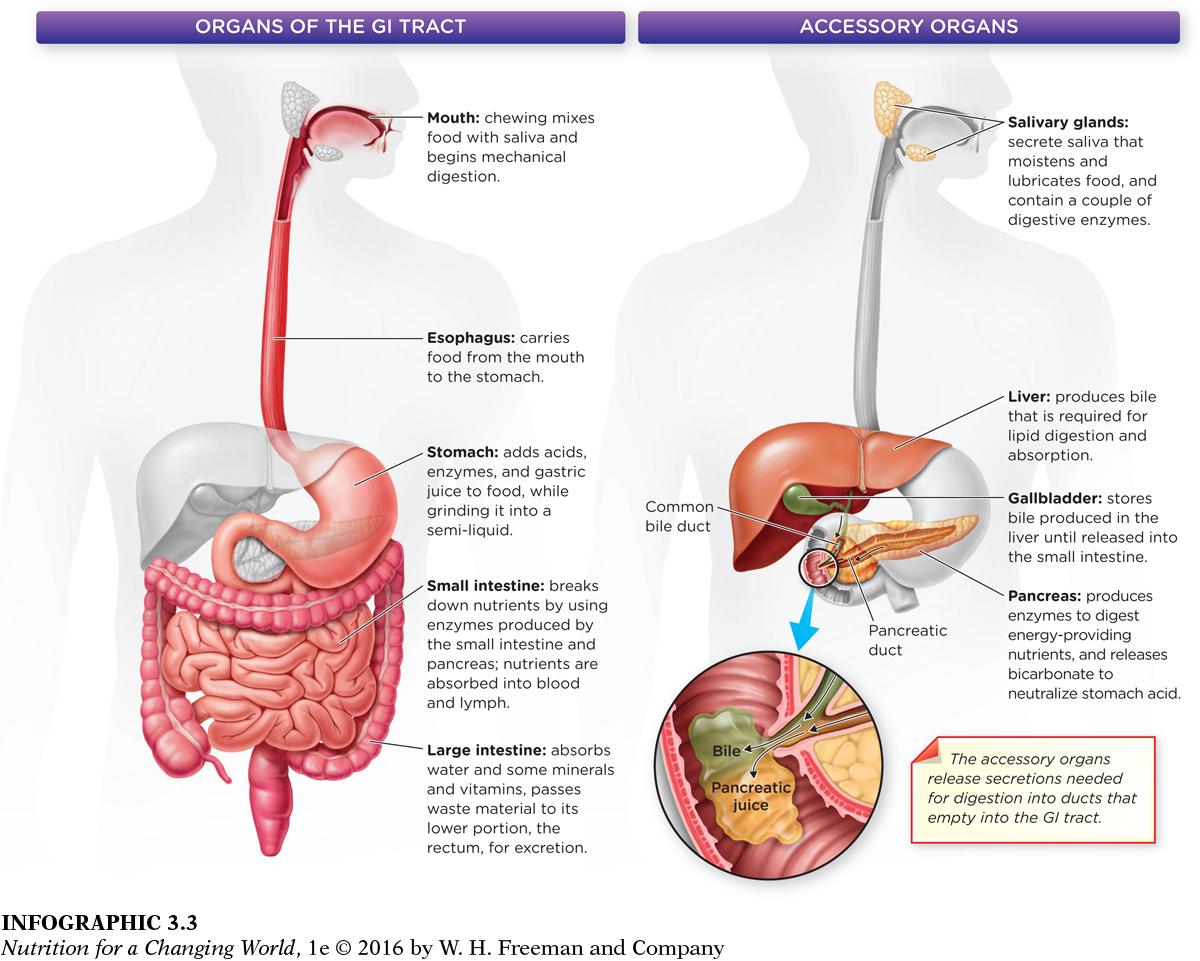OVERVIEW OF THE DIGESTIVE PROCESS
INGESTION the process of taking food or other substances into the gastrointestinal tract via the mouth
GASTROINTESTINAL TRACT tubular channel extending from the mouth to the anus where digestion and absorption occur; also called the alimentary tract
ABSORPTION the process by which nutrients and other substances are removed from the lumen of the gastrointestinal tract to enter the blood stream or lymphatic system
EXCRETION elimination of waste from the body; digestive waste includes any food stuff not absorbed by the intestine
There are four basic stages to the digestive process: First, food is ingested through the mouth and enters the tubular channel called the alimentary canal, also called the gastrointestinal tract. The gastrointestinal (GI) tract extends from the mouth to the anus, and includes the mouth, esophagus, stomach, small intestine, and large intestine. Second, as food passes down the GI tract it is digested, or broken down into smaller units. Third, these smaller units of nutrients are then absorbed, meaning that they pass into the bloodstream or lymphatic system, which transports them throughout the body. Lastly, anything left over is excreted through the opening (the anus) at the other end. (INFOGRAPHIC 3.2)

Question 3.2
 Why is the section of the GI tract that is responsible for absorption so elongated?
Why is the section of the GI tract that is responsible for absorption so elongated?
The portion of the gastorintestinal tract responsible for absorption is elongated to allow the maximum uptake of nutrients.
LUMEN inner space of the GI tract lined with mucosal cells
MUCOSA tissues that line the gastrointestinal tract, made up of mucosal cells (epithelial cells)
MUCUS a viscous solution that lubricates and protects the GI tract
The primary function of the digestive system is to digest, or break down, the nutrients in our foods into compounds that are small enough to be taken up into our body. The inside space of the GI tract is called the lumen, which is lined with a layer of mucosal cells called the mucosa, so named because it is protected by a layer of thick fluid called mucus. Mucosal cells allow our body to absorb nutrients, so that they can be transported by the blood or lymph to where they are needed.
■ ■ ■
Over time, the digestive problems caused by celiac disease can predispose individuals to an early death, as Murray discovered in his research. Between 1948 and 1952, a group of researchers collected blood samples from young Air Force recruits in Wyoming—

What goes wrong, digestively, in patients with celiac disease and how does this threaten their long-
Gastrointestinal Tract and Accessory Organs
As mentioned, the GI tract extends from the mouth to the anus and includes the mouth, esophagus, stomach, small intestine, and large intestine. Because many of these organs fold over onto themselves within the body, the entire GI tract is much longer than it appears—
DIGESTIVE SYSTEM system responsible for digestion, made up of digestive tract (mouth, esophagus, stomach, small intestine and large intestine), and accessory organs (salivary glands, liver, gallbladder, and pancreas)
The digestive system includes the organs of the GI tract and accessory organs: the salivary glands, liver, gallbladder, and pancreas, all of which secrete fluids containing a variety of agents, such as enzymes and acids, that aid in digestion. (INFOGRAPHIC 3.3)

Question 3.3
 What accessory organ produces a compound that is required for lipid digestion and absorption, but is not an enzyme?
What accessory organ produces a compound that is required for lipid digestion and absorption, but is not an enzyme?
The accessory organ that produces a compound required for lipid digestion is the liver. The liver produces bile, which aids in lipid digestion, but is not an enzyme. Bile is stored in the gallbladder.